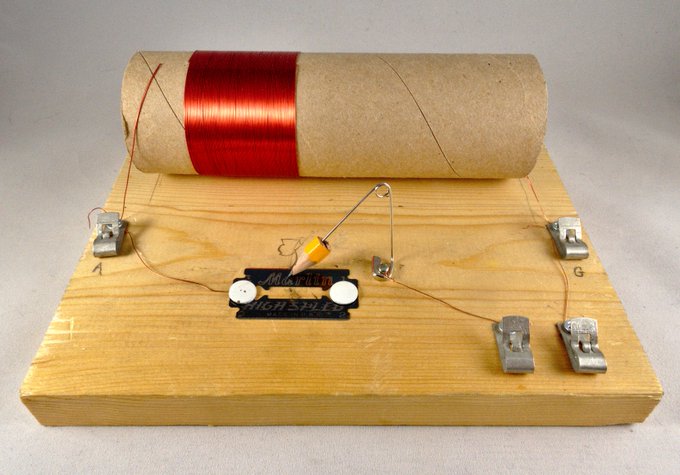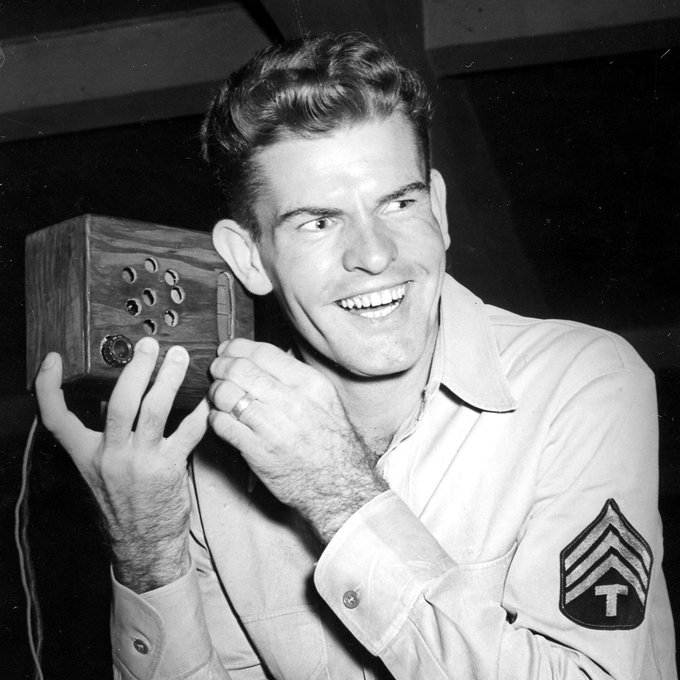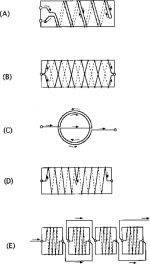CuNiMn resistors are also made by Riedon. Their website will tell you which model uses which metallurgy. Digikey is a distributor.
Actually 100 ohm in series with 100k to ground does *nothing*, certainly nothing audible.
On the other side, the unnecessary inductance you added in series with combined FET gates capacitance, which is huge, puts a tuned circuit at your input.
You are in high danger of picking a TON of RF interference, in exchange of no advantage.
What you built was already made by POWs in Japanese prison camps, in WW2, to listen to Allied broadcast Radios , to hear News about War or simply good Music.
Notice the extreme similarity:


Coil wound in a cylinder? ... check
Detector? .... any non linear junction, such as GS in those Fets.
A happy user:

On the other side, the unnecessary inductance you added in series with combined FET gates capacitance, which is huge, puts a tuned circuit at your input.
You are in high danger of picking a TON of RF interference, in exchange of no advantage.
What you built was already made by POWs in Japanese prison camps, in WW2, to listen to Allied broadcast Radios , to hear News about War or simply good Music.
Notice the extreme similarity:


Coil wound in a cylinder? ... check
Detector? .... any non linear junction, such as GS in those Fets.
A happy user:

Thank you let me know,I am not good at engineering so.
But actually zfoil and metal film sounds different for me.
So you mean wire wound resistor at there is guilty even mills or something?
Lol Japanese prisoners must listened Andean elegy songs as well.
But actually zfoil and metal film sounds different for me.
So you mean wire wound resistor at there is guilty even mills or something?
Lol Japanese prisoners must listened Andean elegy songs as well.
Last edited:
A few years back Dave Slagle wrote about winding coil resistors.
Favourable sound outcome.
Some heating issues.
It'll all be over at Audio Asylum or at Dave's form at Intact Audio
Worth a read and make your own conclusions.
t
and oh yeah....mighta been cathode bypass resistors which I guess is a different species of fish
Favourable sound outcome.
Some heating issues.
It'll all be over at Audio Asylum or at Dave's form at Intact Audio
Worth a read and make your own conclusions.
t
and oh yeah....mighta been cathode bypass resistors which I guess is a different species of fish
Argentine Tango for sure.Lol Japanese prisoners must listened Andean elegy songs as well.
Japanese authorities (justifiably) tried to avoid "Enemy Music" on the radio, so that was one option.
Add to that it was the Golden Era of Tango plus Argentina was always in excellent relations with Japan.
Hey, my own Father spoke some Japanese (learnt in the 40´s) and my Son is extremely fluent in it, go figure.
I never avoid opinions but I love to decide by my own experience.
I have traveled well in my youth and different mind than Japanese soldiers of course.
Next to diyresistor, cinemeg autoformer there.
That seems much chance to pick noise,I shielded with my metal,then sound have got a little quieter
I never think my DIY resistor is very good but until I try Riedon.
I can cover that small resistor with almminium foil.
About inductance, sound get a little carm but bass have got
fatty.
I wound like A on figure,I will try B next time.
I have traveled well in my youth and different mind than Japanese soldiers of course.
Next to diyresistor, cinemeg autoformer there.
That seems much chance to pick noise,I shielded with my metal,then sound have got a little quieter
I never think my DIY resistor is very good but until I try Riedon.
I can cover that small resistor with almminium foil.
About inductance, sound get a little carm but bass have got
fatty.
I wound like A on figure,I will try B next time.
Attachments
tamra, I just realised you haven't been applying the inverse law of sound coloration with the wire you are using. Darker wires provide brighter sounds. I highly recommend you use only grade 1 enamel copper winding wire for your resistors, as that will provide a smooth but not over-bright sound. I would also use winding technique (D) as that keeps all the electrons going from left to right, and not getting them confused about which direction to take, or what is happening with the other winding wire in (B) or going backwards in some sections like in (E). It always helps to use correct and simple first principals.
@tamra: Hi ... just a few comments ... Some years ago I compared the Rhopoint resistors (the GG102 "squaristor") with different other resistors including the Charcroft CAR (Z-foil "nude") and the original Shinkoh tantalum resistors. I compared them in a passive (resistor) I/V output application on my PCM1794 DDDAC inspired DAC.
Although I did very much like the Rhopoint resistor for its very fine midrange fullness and bloom I also found it to have a higher frequency "tizziness" (HF focus) that in the long run would have been less conducive to me ...
On the other hand (again in my application) I really liked the Charcroft CAR - and would here like to add that if the Z-foil you have been listening to are e.g. S102s then the CARs IMHO are quite different: More seamless, more nuanced, almost straight tonal balance (ever, ever, ever so slightly tilting towards brightness), more detailed, more open, faster, altogether providing more presence and life and less coloration. Charcroft makes another resistor which is even higher spec'ed (and nude), however, I have not had the chance to listen to that resistor - but otherwise this is my preferred resistor where circuitry & economy allows for such a revealing resistor.
The Shinkohs - again in my opinion - are quite attractive when it comes to tonal richness and coloring. However, to my ears, this richness is sort of sonorous or slightly resonant - and overall I did not find it to be as open as the CAR resistor.
Saying this in case these experiences may somehow help you in your selection of resistor.
@trobbins:
Hmmm ... just curious here as I am not sure what you are saying here? I would assume that adding a dark sounding wire directly in the signal path would cause the sound to become "darker", whereas adding it to ground (e.g. the 100k input resistor in tamra's circuitry) would cause the sound to become brighter - "darker sound subtracted from main signal = gives brighter main signal" ... everything else being equal, of course ... or might I have misunderstood something here?
Cheers to both of you ;-)
Jesper
Although I did very much like the Rhopoint resistor for its very fine midrange fullness and bloom I also found it to have a higher frequency "tizziness" (HF focus) that in the long run would have been less conducive to me ...
On the other hand (again in my application) I really liked the Charcroft CAR - and would here like to add that if the Z-foil you have been listening to are e.g. S102s then the CARs IMHO are quite different: More seamless, more nuanced, almost straight tonal balance (ever, ever, ever so slightly tilting towards brightness), more detailed, more open, faster, altogether providing more presence and life and less coloration. Charcroft makes another resistor which is even higher spec'ed (and nude), however, I have not had the chance to listen to that resistor - but otherwise this is my preferred resistor where circuitry & economy allows for such a revealing resistor.
The Shinkohs - again in my opinion - are quite attractive when it comes to tonal richness and coloring. However, to my ears, this richness is sort of sonorous or slightly resonant - and overall I did not find it to be as open as the CAR resistor.
Saying this in case these experiences may somehow help you in your selection of resistor.
@trobbins:
I just realised you haven't been applying the inverse law of sound coloration with the wire you are using. Darker wires provide brighter sounds.
Hmmm ... just curious here as I am not sure what you are saying here? I would assume that adding a dark sounding wire directly in the signal path would cause the sound to become "darker", whereas adding it to ground (e.g. the 100k input resistor in tamra's circuitry) would cause the sound to become brighter - "darker sound subtracted from main signal = gives brighter main signal" ... everything else being equal, of course ... or might I have misunderstood something here?
Cheers to both of you ;-)
Jesper
tamra, I just realised you haven't been applying the inverse law of sound coloration with the wire you are using. Darker wires provide brighter sounds. I highly recommend you use only grade 1 enamel copper winding wire for your resistors, as that will provide a smooth but not over-bright sound. I would also use winding technique (D) as that keeps all the electrons going from left to right, and not getting them confused about which direction to take, or what is happening with the other winding wire in (B) or going backwards in some sections like in (E). It always helps to use correct and simple first principals.

I really appreciate for opinions and informations.
Own experience are what I wanted to listen.
There is no definite parts but
I want to blew total balance for adjusting parts.
I will have charcraft car.
Ahh,DDDAC is my next project that I have noticed recently.
Own experience are what I wanted to listen.
There is no definite parts but
I want to blew total balance for adjusting parts.
I will have charcraft car.
Ahh,DDDAC is my next project that I have noticed recently.
I build my own manganin wire resistors used on cathode in a tube preamp. Bifilar wound. They sound better than anything I used before. The only resistor bettered this resistor are the new Audio Note niobium resistor in 2W version
Niobium? I think they saw you coming. Most metals are equally and highly linear in resistance, the choice of which metal is determined by stability (from corrosion), and accuracy requirements: different alloys have different temperature coefficients, so that nichrome, manganin and constantan are typically seen in precision resistors. Alloys typically have higher resistivity than elemental metals, which can affect the choice too.I build my own manganin wire resistors used on cathode in a tube preamp. Bifilar wound. They sound better than anything I used before. The only resistor bettered this resistor are the new Audio Note niobium resistor in 2W version
Niobium is fairly similar to platinum group metals in its resistivity and tempco, but nothing special at all, bog-standard wirewould or metal film will be just as good if competently manufactured, any difference between different metals in linearity is probably sub 1 ppm, so no they do not sound better, you imagine they sound better via expectation bias!
You've been snake-oiled!
Thank you for sharing your experience Cagomat.
Your audio system looks gorgeous ��
Your audio system looks gorgeous ��
Wire wound isnt good for audio as its inductive unless wound back on itself.
So how about gg102a?
FWIW since the late 70´s I wind my own 5W emitter resistors in 0.1 - 0.22 - 0.33 ohm out of Constantan, which is better (almost zero temperature coefficient) than commercially made ones which typically are PTC.
Main reason is precision and repeatability (I cut the exact length needed at any value I wish after I measure ohms per meter) but specially because it´s solderable with regular rosin flux solder (Nichrome requires electrical spot welding)
Lo and behold, it is in the exact same class as fairy dust Manganin, go figure.
So you say now I should charge customers over $22 each? 😱
Although actual cost is some 5 cents for 4 cm of wire? 😎
WAY more metal anyway than in those Magic Mushroom resistors.
Oh well, I guess I should start talking about soundstage, granularity, black noise and microdiodes in my ads.
They might even be directional!!!!! 😛
PS:I think sometimes being a boring Engineer is a CURSE
Main reason is precision and repeatability (I cut the exact length needed at any value I wish after I measure ohms per meter) but specially because it´s solderable with regular rosin flux solder (Nichrome requires electrical spot welding)
Lo and behold, it is in the exact same class as fairy dust Manganin, go figure.
Its main feature is the low thermal variation of its resistivity, which is constant over a wide range of temperatures. Other alloys with similarly low temperature coefficients are known, such as manganin (Cu [86%] / Mn [12%] / Ni [2%] ).
So you say now I should charge customers over $22 each? 😱
Although actual cost is some 5 cents for 4 cm of wire? 😎
WAY more metal anyway than in those Magic Mushroom resistors.
Oh well, I guess I should start talking about soundstage, granularity, black noise and microdiodes in my ads.
They might even be directional!!!!! 😛
PS:I think sometimes being a boring Engineer is a CURSE

Last edited:
- Home
- Design & Build
- Parts
- Manganin wire wound resistor diy
